Comparative Analysis of the Kinematic Characteristics of Lunge-Style and Squat-Style Jerk Techniques in Elite Weightlifters
Abstract
:1. Introduction
2. Methods
2.1. Subjects
2.2. Procedures
2.2.1. Data Collection
2.2.2. Data Analysis and Calculation
2.3. Research Variable
2.4. Statistical Analyses
3. Results
3.1. Comparison of Stage Parameters between the Lunge and Squat Styles in the First Part of the Jerk Action
3.2. Comparison of the Stage Parameters between the Lunge and Squat Styles in the Second Part of the Jerk Action
3.3. Comparison of Stability Factors in the Second Phase of the Jerk between Athletes Using the Lunge Jerk and Squat Jerk Techniques
4. Discussion
5. Limitations
6. Conclusions
Author Contributions
Funding
Institutional Review Board Statement
Informed Consent Statement
Data Availability Statement
Conflicts of Interest
References
- Nagao, H.; Huang, Z.; Kubo, Y. Biomechanical comparison of successful snatch and unsuccessful frontward barbell drop in world-class male weightlifters. Sport Biomech. 2020, 22, 1120–1135. [Google Scholar] [CrossRef] [PubMed]
- Bartonietz, K.E. Biomechanics of the snatch: Toward a higher training efficiency. Strength Cond. J. 1996, 18, 24–31. [Google Scholar] [CrossRef]
- Korkmaz, S.; Harbili, E. Biomechanical analysis of the snatch technique in junior elite female weightlifters. J. Sport Sci. 2015, 34, 1088–1093. [Google Scholar] [CrossRef] [PubMed]
- Ikeda, Y.; Jinji, T.; Matsubayashi, T.; Matsuo, A.; Inagaki, E.; Takemata, T.; Kikuta, M. Comparison of the snatch technique for female weightlifters at the 2008 Asian championships. J. Strength Cond. Res. 2012, 26, 1281–1295. [Google Scholar] [CrossRef]
- Kipp, K.; Harris, C. Muscle-specific effective mechanical advantage and joint impulse in weightlifting. J. Strength Cond. Res. 2017, 31, 1905–1910. [Google Scholar] [CrossRef]
- Kangwei, A.; Deming, L.; Yunde, W. Biomechanical Analysis of the Factors Influencing Jerk Performance. China Sport Sci. 1992, 12, 74–76. [Google Scholar]
- Kangwei, A.; Wenyuan, C. Compairson on the Exercise Structures at Pull Phase Pre-liminary Dip Between the Chinese and Foreign Weightlifters. China Sport Sci. Technol. 1994, 14, 32–34. [Google Scholar]
- Xiangqian, W. Comparison Between Support Technique of Squatting and Support Technique of Splitting in Jerk. J. Shanghai Phys. Educ. Inst. 2000, 53, 65–67. [Google Scholar]
- Hongquan, G.; Xifu, Q.; Haijun, W. Analysis on the Techical Principle of Preliminary Dip in Jerk. China Sport Sci. Technol. 1997, 25, 58–61. [Google Scholar]
- Kai, L.; Shucong, L.; Hongquan, G. Preliminary Study on Braking Technique of Preliminary Dip During. J. Tianjin Inst. Phys. Educ. 1996, 16, 81–84. [Google Scholar]
- Kangwei, A.; Deming, L.; Yunde, W. Power Outputs in the Jerk Phase of Weightlifting. China Sport Sci. 1993, 13, 77–80. [Google Scholar]
- Liu, G.; Fekete, G.; Yang, H.; Ma, J.; Sun, D.; Mei, Q.; Gu, Y. Comparative 3-dimensional kinematic analysis of snatch technique between top-elite and sub-elite male weightlifters in 69-kg category. Heliyon 2018, 4, e658. [Google Scholar] [CrossRef] [PubMed]
- Liu, G.; Zhu, H.; Ma, J.; Pan, H.; Pan, X.; Zhang, Y.; Hu, T.; Fekete, G.; Guo, H.; Liang, M. A Biomechanical Study on Failed Snatch Based on the Human and Bar Combination Barycenter. Appl. Bionics Biomech. 2022, 2022, 927–938. [Google Scholar] [CrossRef] [PubMed]
- Ziying, W.; Jianshe, L.; Gongju, L.; Shanshan, Y.; Guoqiang, S. Biomechanical Analysis of Key Points in Typical Techniques of Squat Clean and Jerk of LI Dayin and LYU Xiaojun—Diagnosis of World Record Breaking at the 2019 World Weightlifting Championships. China Sport Sci. Technol. 2021, 57, 58–65. [Google Scholar]
- Gourgoulis, V.; Aggeloussis, N.; Antoniou, P.; Christoforidis, C.; Mavromatis, G.; Garas, A. Comparative 3-Dimensional Kinematic Analysis of the Snatch Technique in Elite Male and Female Greek Weightlifters. J. Strength Cond. Res. 2002, 16, 359–366. [Google Scholar] [PubMed]
- Harbili, E. A gender-based kinematic and kinetic analysis of the snatch lift in elite weightlifters in 69-kg category. J. Sports Sci. Med. 2012, 11, 162–169. [Google Scholar]
- Nigg, B.M.; MacIntosh, B.R.; Mester, J. Biomechanics and Biology of Movement; Human Kinetics: Champaign, IL, USA, 2000; pp. 12–19. [Google Scholar]
- Ulareanu, M.V.; Potop, V.; Timnea, O.C.; Cheran, C. Biomechanical Characteristics of Movement Phases of Clean & Jerk Style in Weightlifting Performance. Procedia Soc. Behav. Sci. 2014, 137, 64–69. [Google Scholar]
- Xiangqian, W.; Xiaoyan, W.; Wenyi, W. Kinematical Comparative Study between Split Jerk andDrop Jerk in Female Weightlifters. China Sport Sci. 2002, 23, 127–132. [Google Scholar]
- Ye, B.; Liu, G.; He, Z.; Xu, J.; Pan, H.; Zhu, H. Biomechanical mechanisms of anterior cruciate ligament injury in the jerk dip phase of clean and jerk: A case study of an injury event captured on-site. Heliyon 2024, 10, e31390. [Google Scholar] [CrossRef]
- Harbili, E.; Alptekin, A. Comparative kinematic analysis of the snatch lifts in elite male adolescent weightlifters. J. Sports Sci. Med. 2014, 13, 417–422. [Google Scholar]
- Cohen, J. Quantitative Methods In Psychology: A Power Primer. Psychol. Bull. 1992, 112, 1155–1159. [Google Scholar] [CrossRef] [PubMed]
- Deming, L.; Kangwei, A.; Yunde, W. Three Dimensional Analysis of Jerk Techniques for Five FemaleWeightlifting Champions at 11th Asian Games. China Sport Sci. 1992, 12, 74–79. [Google Scholar]
- Hedrick, A. Dumbbell Power Clean, Front Squat, and Power Jerk. Strength Cond. J. 2015, 37, 84–88. [Google Scholar] [CrossRef]
- Kipp, K.; Redden, J.; Sabick, M.; Harris, C. Kinematic and Kinetic Synergies of the Lower Extremities During the Pull in Olympic Weightlifting. J. Appl. Biomech. 2012, 28, 271–278. [Google Scholar] [CrossRef]
- Moon, Y.J. Performance Enhanced Model in Snatch Weightlifting—Using the kinematic factors. J. Biomech. 2007, 40, S753. [Google Scholar] [CrossRef]
- Weimin, W. How to Improve the Success Rate of Weightlifting Arrow Jerk. J. Shanghai Phys. Educ. Inst. 1993, 35, 29–31. [Google Scholar]
- Xian, C. The Cognition and Comparison of Squatting Downwards, Lifting up wards and Arrow Pace Lifting. J. Nanjing Inst. Phys. Educ. 2002, 25, 27–28. [Google Scholar]
- Zhaoxin, C.; Guiping, S. Discussion on Advantages and Disadvantages of Drop Jerk in Clean and Jerk. J. Beijing Univ. Phys. Educ. 2000, 52, 408–410. [Google Scholar]

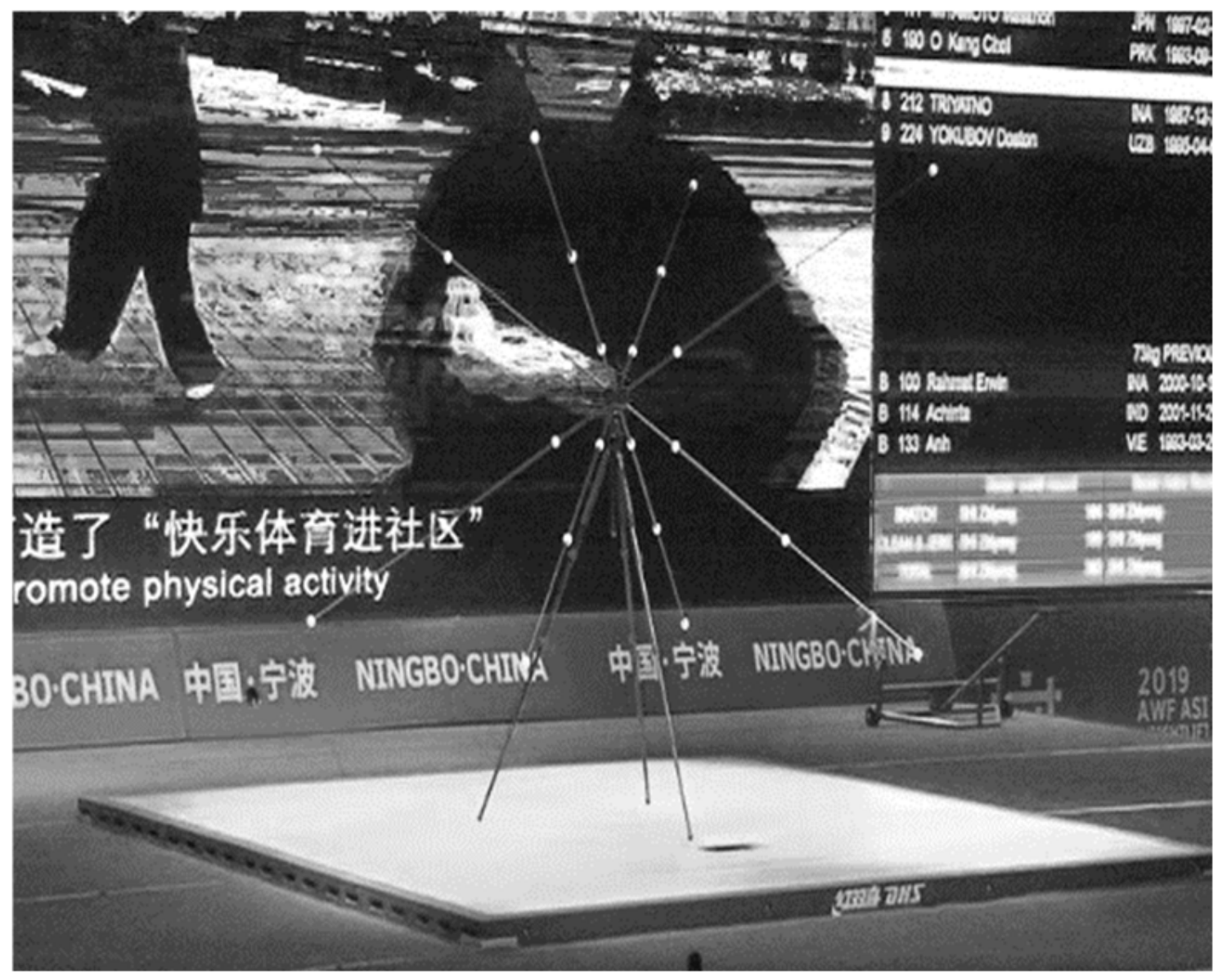
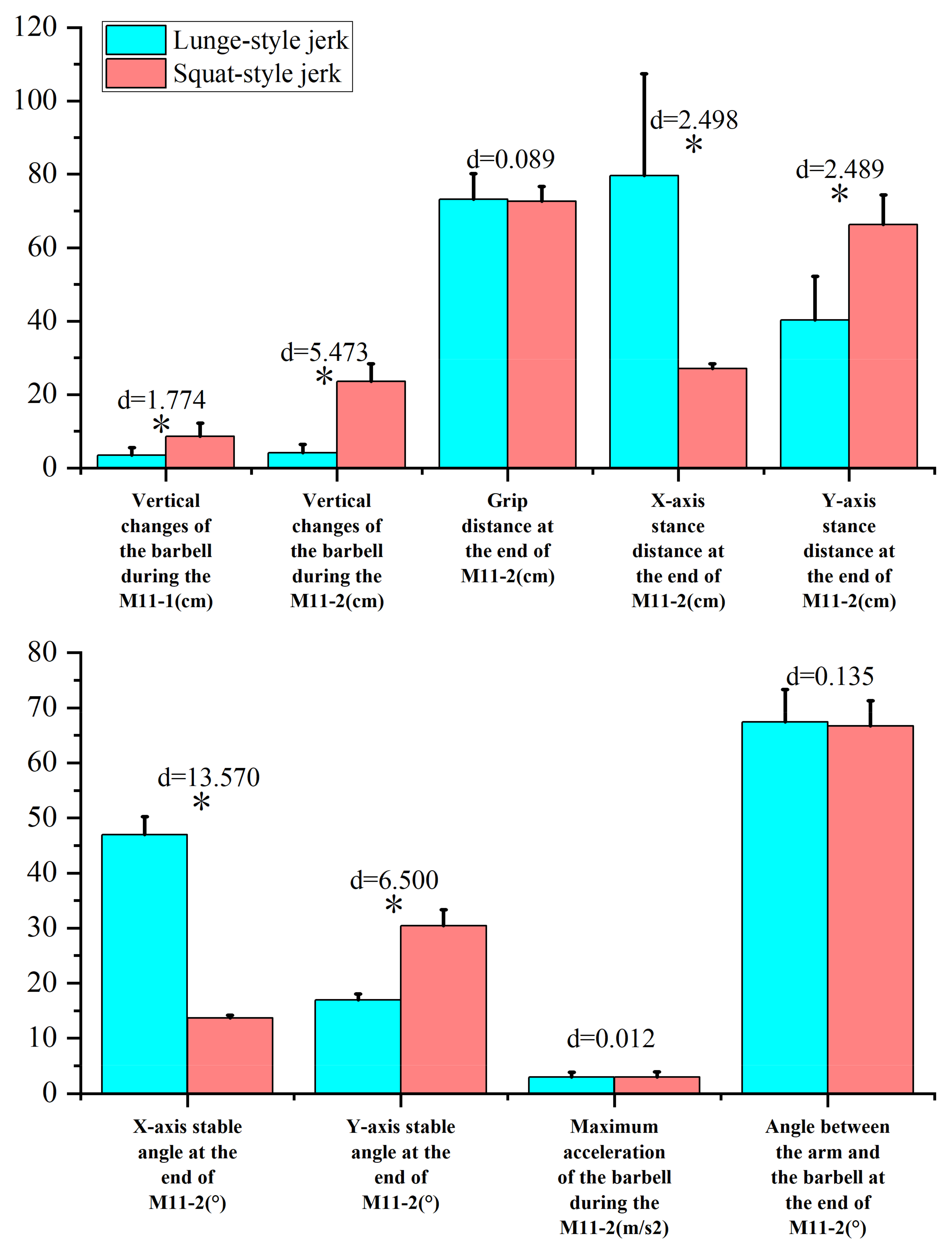

| Phase | Lunge-Style Jerk | Squat-Style Jerk |
|---|---|---|
| M7: Preparation phase From the end of the clean action to the beginning of the squatting knee flexion |  |  |
| M8: pre-squat phase (From the beginning of the squatting knee flexion to the moment of the smallest knee joint angle) | ||
| M8-1: Active pre-squat stage From the onset of pre-squat to the moment of maximum barbell falling velocity |  | 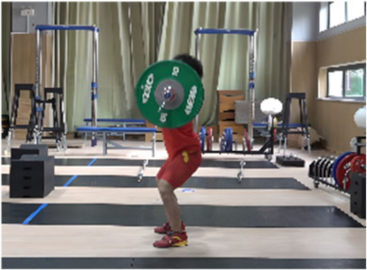 |
| M8-2: Pre-squat braking stage From the moment of maximum barbell falling velocity to the moment of the smallest knee joint angle | 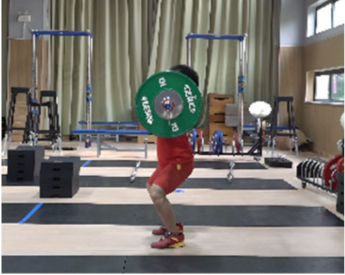 | 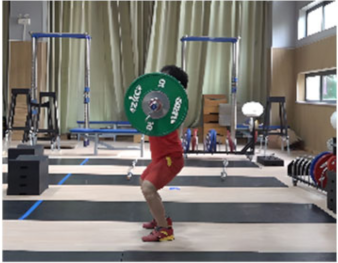 |
| M9: Force phase From the moment of the smallest knee joint angle to the moment of maximum vertical velocity of barbell |  | 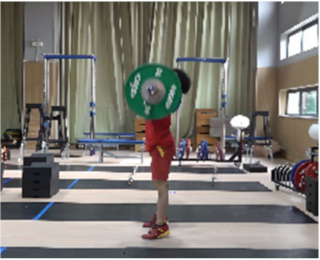 |
| M10: Inertial rising phase From the moment of the maximum vertical velocity of the barbell to the moment of the first peak value of the vertical height of the barbell |  |  |
| M11: Squat-supporting phase (From the moment of the first peak value of the barbell vertical height to the moment of the lowest point of barbell falls again) | ||
| M11-1: Squat shoulder locking stage From the moment of the first peak value of the barbell vertical height to the moment of maximum barbell falling velocity |  | 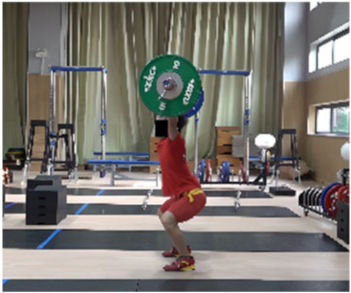 |
| M11-2: Active supporting stage From the moment of maximum barbell falling velocity to the moment of the lowest point of barbell falls again |  | 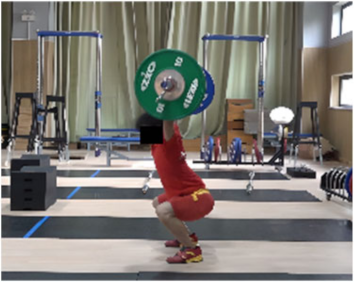 |
| M12: Standing-up phase From the moment of the lowest point of the barbell falls again to the second peak value of the barbell vertical height | 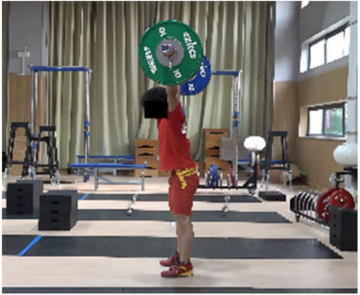 |  |
| End of M7 | M8 | End of M9 | End of M10 | M11 | End of M12 | ||||
|---|---|---|---|---|---|---|---|---|---|
| End of M8-1 | End of M8-2 | End of M11-1 | End of M11-2 | ||||||
| Time duration(s) | Lunge style | 2.57 ± 2.37 | 0.23 ± 0.07 | 0.15 ± 0.04 | 0.25 ± 0.04 | 0.23 ± 0.02 | 0.11 ± 0.06 | 0.19 ± 0.08 | 1.34 ± 0.40 |
| Squat-style | 3.19 ± 1.65 | 0.17 ± 0.04 | 0.16 ± 0.04 | 0.25 ± 0.04 | 0.22 ± 0.02 | 0.15 ± 0.06 | 0.58 ± 0.21 | 1.93 ± 0.75 | |
| p-value | 0.341 | 0.003 | 0.488 | 1.00 | 0.496 | 0.029 | <0.001 | 0.03 | |
| Cohen’s d | 0.297 | 1.018 | 0.250 | 0 | 0.5 | 0.667 | 2.59 | 1.021 | |
| Front hip joint angle (°) | Lunge style | 162.21 ± 8.48 | 141.04 ± 6.57 | 134.83 ± 7.31 | 161.80 ± 6.80 | 114.71 ± 7.06 | 99.76 ± 7.68 | 94.76 ± 9.9 | 168.13 ± 6.58 |
| Squat-style | 158.27 ± 6.11 | 138.86 ± 7.09 | 128.52 ± 7.82 | 157.44 ± 6.71 | 122.95 ± 11.41 | 90.75 ± 8.98 | 51.84 ± 7.13 | 155.55 ± 6.96 | |
| p-value | 0.100 | 0.318 | 0.012 | 0.050 | 0.009 | 0.002 | <0.001 | 0.139 | |
| Cohen’s d | 0.522 | 0.321 | 0.838 | 0.645 | 0.896 | 1.09 | 4.871 | 1.865 | |
| Back hip joint angle (°) | Lunge style | 162.64 ± 9.13 | 141.52 ± 6.95 | 134.84 ± 7.74 | 162.07 ± 7.11 | 143.18 ± 8.23 | 150.65 ± 8.49 | 151.90 ± 8.55 | 159.12 ± 7.68 |
| Squat-style | 158.77 ± 6.48 | 138.56 ± 6.98 | 128.23 ± 7.65 | 157.37 ± 6.96 | 122.40 ± 11.19 | 90.56 ± 9.02 | 51.65 ± 6.97 | 155.15 ± 6.37 | |
| p-value | 0.159 | 0.186 | 0.010 | 0.041 | 0.000 | <0.001 | <0.001 | 0.083 | |
| Cohen’s d | 0.478 | 0.425 | 0.858 | 0.667 | 2.16 | 6.889 | 12.679 | 0.556 | |
| Front knee joint angle (°) | Lunge style | 163.01 ± 10.98 | 119.77 ± 5.44 | 106.4 ± 5.62 | 168.50 ± 6.47 | 109.30 ± 6.22 | 103.88 ± 6.40 | 102.06 ± 7.88 | 160.88 ± 9.00 |
| Squat-style | 159.14 ± 4.25 | 121.2 ± 6.61 | 110.2 ± 11.38 | 163.91 ± 6.72 | 102.86 ± 9.03 | 77.35 ± 10.06 | 43.64 ± 7.32 | 159.75 ± 8.86 | |
| p-value | 0.150 | 0.458 | 0.188 | 0.041 | 0.012 | <0.001 | <0.001 | 0.693 | |
| Cohen’s d | 0.443 | 0.239 | 0.442 | 0.698 | 0.852 | 3.242 | 7.643 | 0.126 | |
| Back knee joint angle (°) | Lunge-style | 162.95 ± 11.16 | 120.16 ± 6.24 | 106.75 ± 6.31 | 168.01 ± 6.8 | 147.12 ± 10.31 | 136.22 ± 12.48 | 143.28 ± 11.35 | 160.13 ± 11.00 |
| Squat-style | 159.37 ± 4.76 | 121.68 ± 6.14 | 110.28 ± 11.12 | 163.67 ± 6.69 | 102.77 ± 8.85 | 77.17 ± 9.93 | 43.56 ± 7.26 | 160.48 ± 9.23 | |
| p value | 0.195 | 0.442 | 0.225 | 0.049 | <0.001 | <0.001 | <0.001 | 0.915 | |
| Cohen’s d | 0.399 | 0.245 | 0.405 | 0.643 | 4.569 | 5.158 | 10.18 | 0.034 | |
| Vertical height of barbell (cm) | Lunge-style | 132.27 ± 2.73 | 123.04 ± 2.76 | 114.05 ± 2.82 | 134.29 ± 2.38 | 155.22 ± 5.92 | 151.46 ± 4.83 | 147.35 ± 5.87 | 179.06 ± 5.21 |
| Squat-style | 133.56 ± 4.78 | 124.06 ± 4.72 | 115.02 ± 5.2 | 134.85 ± 4.43 | 154.94 ± 4.20 | 146.66 ± 7.32 | 123.06 ± 4.19 | 179.83 ± 5.39 | |
| p value | 0.300 | 0.406 | 0.464 | 0.624 | 0.865 | 0.019 | <0.001 | 0.648 | |
| Cohen’s d | 0.344 | 0.273 | 0.241 | 0.164 | 0.053 | 0.796 | 4.661 | 0.146 | |
| Vertical velocity of barbell (m/s) | Lunge-style | 0 | −0.91 ± 0.12 | 0 | 1.53 ± 0.08 | 0 | −0.41 ± 0.17 | 0 | 0 |
| Squat-style | 0 | −0.89 ± 0.08 | 0 | 1.52 ± 0.14 | 0 | −0.88 ± 0.14 | 0 | 0 | |
| p value | — | 0.727 | — | 0.723 | — | <0.001 | — | — | |
| Cohen’s d | 0.191 | 0.091 | 2.98 | ||||||
| Distance between the two centers on the X axes (cm) | Lunge-style | 1.42 ± 0.54 | 1.25 ± 0.81 | 1.41 ± 0.70 | 2.91 ± 1.50 | 2.06 ± 1.90 | 2.94 ± 2.16 | 4.26 ± 2.07 | 4.23 ± 2.56 |
| Squat-style | 1.20 ± 0.88 | 1.22 ± 0.92 | 1.31 ± 0.83 | 1.53 ± 1.22 | 1.99 ± 1.18 | 3.28 ± 1.67 | 3.15 ± 2.57 | 3.44 ± 1.80 | |
| p value | 0.345 | 0.921 | 0.683 | 0.003 | 0.895 | 0.581 | 0.14 | 0.268 | |
| Cohen’s d | 0.311 | 0.035 | 0.132 | 0.996 | 0.043 | 0.173 | 0.483 | 0.349 | |
| Distance between the two centers on the Y axes (cm) | Lunge-style | 2.42 ± 0.86 | 2.49 ± 1.16 | 2.44 ± 1.20 | 2.83 ± 1.53 | 3.44 ± 1.77 | 3.63 ± 1.85 | 3.84 ± 1.84 | 3.73 ± 2.17 |
| Squat-style | 2.1 ± 1.10 | 2.18 ± 1.11 | 2.16 ± 1.12 | 1.68 ± 1.15 | 2.62 ± 1.27 | 3.25 ± 1.80 | 3.73 ± 2.36 | 3.32 ± 2.18 | |
| p value | 0.31 | 0.385 | 0.447 | 0.011 | 0.101 | 0.515 | 0.876 | 0.554 | |
| Cohen’s d | 0.330 | 0.272 | 0.240 | 0.834 | 0.521 | 0.208 | 0.053 | 0.189 | |
| Distance between the two centers on the Z axes (cm) | Lunge-style | 37.27 ± 1.64 | 34.92 ± 1.17 | 30.97 ± 1.36 | 37.65 ± 1.06 | 73.30 ± 3.57 | 74.68 ± 2.46 | 72.16 ± 2.75 | 79.97 ± 3.03 |
| Squat-style | 38.02 ± 1.53 | 36.03 ± 1.40 | 32.23 ± 1.18 | 38.63 ± 1.33 | 73.16 ± 2.97 | 75.49 ± 2.83 | 69.18 ± 3.13 | 81.30 ± 2.95 | |
| p value | 0.357 | 0.01 | 0.003 | 0.014 | 0.892 | 0.34 | 0.003 | 0.167 | |
| Cohen’s d | 0.471 | 0.871 | 0.980 | 0.828 | 0.042 | 0.308 | 1.021 | 0.444 | |
Disclaimer/Publisher’s Note: The statements, opinions and data contained in all publications are solely those of the individual author(s) and contributor(s) and not of MDPI and/or the editor(s). MDPI and/or the editor(s) disclaim responsibility for any injury to people or property resulting from any ideas, methods, instructions or products referred to in the content. |
© 2024 by the authors. Licensee MDPI, Basel, Switzerland. This article is an open access article distributed under the terms and conditions of the Creative Commons Attribution (CC BY) license (https://creativecommons.org/licenses/by/4.0/).
Share and Cite
Liu, G.; He, Z.; Ye, B.; Guo, H.; Pan, H.; Zhu, H.; Meng, G. Comparative Analysis of the Kinematic Characteristics of Lunge-Style and Squat-Style Jerk Techniques in Elite Weightlifters. Life 2024, 14, 1086. https://doi.org/10.3390/life14091086
Liu G, He Z, Ye B, Guo H, Pan H, Zhu H, Meng G. Comparative Analysis of the Kinematic Characteristics of Lunge-Style and Squat-Style Jerk Techniques in Elite Weightlifters. Life. 2024; 14(9):1086. https://doi.org/10.3390/life14091086
Chicago/Turabian StyleLiu, Gongju, Zhanyang He, Binyong Ye, Haiying Guo, Huiju Pan, Houwei Zhu, and Guanliang Meng. 2024. "Comparative Analysis of the Kinematic Characteristics of Lunge-Style and Squat-Style Jerk Techniques in Elite Weightlifters" Life 14, no. 9: 1086. https://doi.org/10.3390/life14091086





